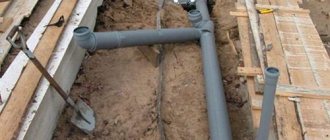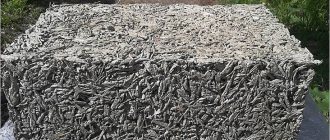What is a dry water seal for sewerage?
Water seal for sewerage
A water seal is a device installed in sewer pipes. It solves two problems. The first is the unpleasant odor that forms in the sewer due to the proliferation of microorganisms and rotting processes. Secondly, it prevents water hammer: sewerage is a hermetically sealed system, water passing through it and not being able to expand, can damage the pipes. A water seal is installed in sinks, bathtubs, and showers. Toilets are supplied with it during production and do not require additional installation.
They are divided into several types according to configuration and installation method; in addition, they distinguish between regular and dry water seals for sewerage. The principle of operation of the first is to create a water plug in such a way that it hermetically seals the pipes, preventing the penetration of volatile gases from the sewer into the room.
The dry one consists of tubes, one end of which is attached to the sink or drain, the other to the drain pipe going into the sewer well. There is a siphon between the pipes. This is an expanded container in which water accumulates. The siphon is located 50 mm below the drain level, which allows water to accumulate, creating a plug.
A simpler water seal is a U-shaped bent pipe. In this case, water collects at the bottom of the device. The principle of operation is the same as that of a device with a siphon.
With constant use of the sewer, the water collected in the container is forced out into the drain, thus constantly updating the liquid level.
Types of hydraulic valves for sewerage
The classification of devices is made taking into account several factors, but the main ones are design features. Based on the technical nuances, we can distinguish six main types of water seals; let’s look at each of them in more detail.
#1: Features of the knee modification
A knee water seal can be identified by its appearance - it resembles the letter U. The advantage of this type is its strength, which allows it to withstand maximum pressure in the pipes. The throughput of the device depends on the cross-section of the pipe, which should not be less than the output of the plumbing equipment.
The main places in the sewer system where it is appropriate to install knee water seals are bathtub and toilet drains. Sometimes, instead of one, two siphons are connected.
For the manufacture of knee devices, cast iron and even bronze were previously used, but now it is more expedient and cheaper to use modern material - polypropylene, which is lightweight, reliable and easy to install.
There are different types of knee siphons. Some of them are a single plastic device that cannot be adjusted. If it breaks, it must be dismantled entirely.
Other devices consist of several parts, so if necessary, you can increase the length of the pipes and change their position in order to adjust the volume of water. The position of the pipes is fixed with overhead plastic clamps and nuts.
The knee has two bends - at the entrance and at the exit. The point of the second inflection should be slightly lower than the point of the first (5-6 cm). Sometimes an S-shaped design is used for a more secure lock; its operating principle is the same.
Cleaning knee structures is done in two ways:
- by completely dismantling the device;
- special flexible cable.
Some polypropylene versions are equipped with an inlet for the drain hose of a washing machine or dishwasher.
Image gallery
Photo from
Knee siphon model
Knee device kit
Assembly option for side connection
Assembly with bottom connection to sewerage
#2: Benefits of a bottle device
This type of water seal is popular in kitchens for equipping drains under sinks and dishwashers. During the process of washing dishes and pots, some food waste enters the system, which can cause a blockage.
The design of the bottle model retains food residues, which helps maintain the performance of the sewer system. In addition, the bottle device retains its main purpose - to prevent the appearance of unpleasant odors in the home.
In addition to the pipes that form the basis of any water seal, this type is equipped with an additional element - a “bottle”. This is a kind of container for collecting food waste. The sump is located below the level of the drain pipe, so it is easy to get to it if necessary.
The two parts of the bottle model are connected in the following way: first, the vertical pipe enters the sump located below, then the horizontal pipe exits from the side towards the sewer pipe
The bottle device is made of polypropylene, but is considered weaker in strength than its knee counterpart. The fact is that unreliable connections cannot withstand strong water pressure, so this type is used exclusively in the kitchen and is absolutely not suitable for equipping a toilet or bathroom.
A blockage in the water seal occurs when a dense mass of food debris completely clogs the sump and blocks the path of water. Thanks to the bottle configuration, clearing the blockage is very easy.
It is enough to unscrew the cap nut that attaches to the sump and shake out the accumulated debris from it. Then you need to put the “bottle” in place and tighten the nut more tightly, otherwise water may leak out.
Bottle structures are also useful in terms of preserving items that accidentally fall into the drain. Careless housewives often took their rings out of the settling tanks, slipping off their fingers while washing dishes with soap.
Image gallery
Photo from
Bottle siphon body
Bottle device equipment
Drain with catch grid
Corrugated discharge pipe
#3: Double-turn water seal device
The design of a double-turn hydraulic seal resembles a knee valve, but has a more complex configuration. The drain pipe is connected to the outlet of the plumbing fixture, and at the junction it is equipped with a filter grid to retain waste, hair and other debris.
Then it smoothly turns into an elbow, which ends with a connection to another pipe. The last element is directed towards the drain and is at a slight angle.
Some double-turn models are equipped with an inspection hole for pipe cleaning, tightly closed with a plug. The function of the hole is sometimes performed by a removable fragment of the knee. The hole is usually located at the lowest point, and the removable part is located at the top
Household double-turn structures were previously made of cast iron, now they are made of polypropylene. Cast iron analogues can only be used in industrial enterprises with increased volumes of wastewater and high pressure in pipes. Chrome-plated parts, which are similar in technical characteristics to polypropylene, look more presentable.
If we compare this model with a bottle alternative, the second option is easier to maintain. However, the double-turn device is more reliable in terms of protection against leakage and, thanks to its simple adjustable design, can be installed even in narrow spaces.
#4: Corrugated model – pros and cons
Among the propylene modifications, there are also corrugated models - durable, flexible, sometimes simply necessary for arranging a sewer system in small spaces. Due to the plasticity of the pipe, corrugated pipes are placed in places where it is difficult to place other types of structures.
It can be rotated at the desired angle and directed in any direction, whereas firmly fixed plastic has only a few position options.
A corrugated water seal is often placed under the bathtub, since less flexible models do not fit in the narrow space between the bottom of the container and the floor. One end is connected to the drain hole, the other to the outlet into the sewer pipe
However, when choosing a corrugated option, you should be aware of its only, but significant, drawback. The ribbed walls of the pipe seem to be designed to collect debris: food debris, hair, pieces of soap, sand and other dirt get stuck in them. Taking this into account, when installing the corrugation, the drain must be equipped with a filter in the form of a fine mesh grid.
If you do not clean the corrugated water seal for a long time, under the influence of dirt and excess weight it loses strength and elasticity. Over time, the folds wear out, begin to crack and let water through.
After installing a flexible siphon, be sure to monitor its condition and clean it in a timely manner. You can guess that the pipe is dirty by the sagging that forms in places where grease and debris accumulate.
Image gallery
Photo from
Corrugated siphon for connecting plumbing
Corrugated siphon in assembled state
Handicraft formation of a water seal
Use in double-turn siphon
#5: How the overflow works
Another type of siphon - with an overflow - can also be placed in a separate category, since it is necessarily equipped with an additional pipe. The main purpose of the overflow equipment is to protect the apartment from flooding if for some reason the water stops going down the drain when the tap is open.
The sinks on which this device is installed have an additional hole - in the upper part of the bowl, under the mixer. When the level of water accumulated in the sink reaches a critical level, liquid begins to flow into this hole and further into the water seal (+)
Bathtubs must be equipped with an overflow system. This method prevents flooding, but, unfortunately, does not contribute to savings. If you want to run a bath and forget to turn off the tap in time, the water, having reached the overflow level, will safely leave the container and go down the drain - along with your money for paying for utilities.
The market offers both economical plastic options and more durable but less elastic metal models. The disadvantages of brass-bronze equipment are the complexity of installation and high cost.
When choosing a device, do not forget to inquire about its throughput. If the overflow cannot cope with the volume of excess liquid, it is useless and even dangerous.
#6: Dry seal design
The design of the so-called “dry” valve is radically different from its hydraulic counterparts. It works on the “nipple” principle and is a threaded pipe with a check valve installed inside. As a result, water entering the device cannot flow back out, just as the smell does not have a chance to leave the pipe.
The installation of such devices is justified on the lower floors of multi-storey buildings, as well as in places where water is used less frequently (in bathhouses).
Dry valves are generally not installed in kitchen sinks, the use of which is highly likely to create blockages. But such devices with a water seal work effectively and last a long time in shower cabins built by yourself.
The “dry” type valve does not require constant presence of water inside the housing. Even if it functions in conjunction with a knee device, it does not need to be monitored or adjusted
There are several types of dry devices:
- membrane, overlapping after draining the water with an elastic membrane;
- pendulum, tending to close instantly if no liquid is supplied;
- float valves that close the hole when water leaves the drain (acting like the fittings of a flush tank).
The latter are often made independently, arranging sewer lines in bathhouses.
The principle of operation of a float valve is considered the simplest. Light weight keeps the float on the surface of the water. As soon as it drains, the float moves down and blocks the drain.
If the sewer lines suddenly dry out due to infrequent use, thanks to the dry seal, the unpleasant smell will not bother you.
Criteria for selecting water seals
How does a dry shutter work?
When choosing a water seal, you need to take into account some nuances, one of which is how often the sewer will be used. If this is a shower in the country and its use is insignificant, the water in the siphon, without being renewed, will evaporate over time in 40-50 days. After this period, fetid sewer odors will penetrate into the room.
Heated floors, hot climates or, conversely, the use of sewerage during frosts, when the water in the siphon can freeze and even break it - these are indications for using a dry water seal. They are more advanced, do not allow odors to penetrate and prevent liquid from entering from the sewer, if the apartment is located on the ground floor of a high-rise building.
When choosing a water seal in a store, you should pay attention first of all not to the price, but to the type of plumbing for which it will be used. For bathrooms and saunas, the diameter of the drain pipe must be greater than 110 mm. A knee siphon with a large capacity that can withstand high pressure is suitable. The downside is that this is a non-removable structure; in this case, the blockage can only be cleared using a plumbing cable.
For the sink, choose designs with a collapsible siphon. The most convenient, according to consumer reviews, is the bottle type. It has a large volume, this will allow you to quickly and infrequently clean the sewer clog.
It is recommended to disassemble and clean devices at least once every six months, even if there is no apparent reason for this. It must be installed in such a way that access to it is convenient.
Installation features
Homemade shutters turn out to be quite large. There are no problems with placement under a washbasin or kitchen sink.
If we are talking about a shower stall or bathtub, then it is better to provide for the installation of such an element in advance - before installing the floors in the room where it is planned to install this sanitary fixture.
Since domestic sewerage is gravity-fed and there is no excess pressure in it, there is no need to use strong threaded connections sealed with tow or fum tape. Typically a socket connection with a rubber O-ring is used.
Such a connection can be sealed using sealant (silicone) and metallized tape intended for pipe repair.
If you don’t have any suitable materials in your workshop, you can use the “old-fashioned” method: tow is wound around the pipe inserted into the socket, and after installing the part, the joint is sealed with cement mortar.
Types of structures
Types of siphons
There are several types of dry valves: membrane, pendulum, float, and with molecular memory.
The diaphragm valve operates on the nipple principle. The membranes are attached to the screw-on pipe by means of a spring. Under the pressure of water, the valve opens, letting it through. When the pressure in the system stops, the springs return the valve to its place, pressing it tightly against the tube. Thus, the smell does not spread and the liquid from the sewer does not spread.
The float valve is a combined design. When water is present in the siphon, a light, air-filled float floats, but when the water dries up, it sinks, blocking the sewer hole. This option cannot be used at low temperatures to prevent the liquid from freezing.
Pendulum shutter - operates according to the law of gravity. The pendulum is mounted in the siphon perpendicular to the opening of the sewer drain pipe. Its diameter should be equal to the diameter of the pipe, this will allow the sewer to be hermetically sealed. Under the influence of water flow, the pendulum deviates, opening the hole in the drain channel; after the liquid passes, the pendulum, under the influence of gravity, returns to its original position.
A water seal with molecular memory is a modern high-tech invention based on the ability of some elastic materials to restore a given shape after deformation stops.
It is advisable to buy a dry water seal for the shower, additionally equipped with a drain, concreted or built into the floor. It is equipped with a grille that prevents the entry of debris; it can be closed if necessary, serving as an additional barrier to the penetration of odors from the sewer. In addition, the drain provides a hermetic connection with the floor of the bathhouse or shower.
How to choose a siphon
The choice of a water seal for plumbing is made according to several criteria:
- Product dimensions. It must fit in the installation location.
- Shutter model
- Material for manufacturing the sewer system
- Quantity of drainage and presence of overflow on plumbing fixtures.
- Inlet and outlet diameter.
Attention! When purchasing a siphon with an overflow, pay attention to the diameter of the pipe; if it is too small, the throughput will be low, and if necessary, the overflow system will not cope with the flow of liquid.
Do-it-yourself water seal for sewerage
DIY design example
The simplest design that you can make yourself is a knee water seal. For its manufacture, a plastic pipe with the same diameter as the drain is suitable. It needs to be bent into a U shape and tightly connected to the sewer pipes using couplings. The diameter of the siphon does not always coincide with the diameter of the pipes; in this case, it is advisable to use an adapter, a plastic ring having two different diameters.
One is the size of a siphon, the other is the size of a sewer drain. The sealing ring can be lubricated with silicone sealant for reliability. Make sure that the bend is 50-70 mm below the sewer drain hole. For a dry water seal, you can take a tennis ball slightly larger than the diameter of the pipe. It is necessary to make a chamber in which it will be located, connect the chamber with sewer pipes.
While there is a water plug in the siphon, the ball floats; when the water evaporates, it lowers like a float, closing the drain pipe. This homemade water seal can be used even in cold weather. If the ball freezes to the pipe, pour hot water into the drain and the problem will be solved.
Where can I buy
You can purchase a water seal for sewerage at any plumbing store, as well as in many hardware and construction supermarkets. The cost of a product is influenced primarily by its type, size and brand. To a certain extent, the price is also affected by the region of the Russian Federation in which the purchase was made.
For example, in Chelyabinsk (Santekhorbita, EuroDom stores, online store World of Plumbing) and Rostov-on-Don (online store SantekhMega, SantekhOpt, Three Inch stores) similar products are sold on average 10% cheaper than in the capital (“Plumbing Store”, “House of Plumbing”, “SUpSan”), Tyumen (“Water Magician”, online stores “Ark” and “Aquatoria”) and Novosibirsk ( online store “Plumbing of Siberia”, m-ns “Meduza” and “AquaTermService”).
Tips and tricks for use
For sinks, do not use a corrugated siphon, despite the fact that these pipes are flexible and compactly laid. The downside is that debris is deposited in the bends of the corrugation, and the diameter of the pipe decreases. It is advisable to use it for a bath.
It is undesirable to expose the water seal to boiling water or hot oil - this will lead to cracks in the pipe and, as a result, leakage.
For rarely used plumbing fixtures, only dry water seals are required. If there is a cold effect on the sewer, you should not use a combined float design. Modern siphons are made of polymer materials, they do not rot, are easy to install, and serve for a long time. Metal products are chrome plated to resist corrosion.
The reason for the appearance of an odor in a room with properly installed hydraulic equipment can be depressurization of drain pipes, a long-term operated sewer system in which bacteria multiply on the vessel wall, or a broken water plug. To check the tightness of the equipment, you need to bring a lit candle to the opening of the sink or toilet. If the flame does not fluctuate, there is no depressurization and it is enough to pour a disinfectant into the sewer.
Plug failure occurs if the diameter of the sewer pipes is small and the volume of drained water is significant. A pressure difference is created in the pipes and the liquid moves in the opposite direction. In this case, it is enough to open the tap for 2-3 minutes so that the water restores the seal in the siphon. This will solve the odor problem.
Design and principle of operation
Another name for the device is siphon.
In most cases, it is a curved section of U-shaped pipe.
This shape allows water to remain constantly in the device. A layer of water prevents odors from the pipeline from entering the room.
The water seal is installed on a plumbing device that removes liquid waste:
- shells,
- sinks,
- toilets and so on.
What do you know about the Mayevsky tap for 15 mm cast iron radiators? Read in this useful article where and why it is needed, as well as how to install it yourself.
Wood-burning hot water titanium is written about in this article.
Once in the siphon, water displaces the liquid that was there before. There is a constant change in the filling of the shutter, which prevents the appearance of unpleasant odors.
The design of the siphon is very simple and does not require any modifications (read about the rules for water treatment from a well for a private home here).
The difference in the pressure of the risers will not allow water to leave the siphon, but flushing of waste occurs without difficulty.
IMPORTANT! The smell of sewage appears if there is no water in the valve (it has evaporated when the device was not used or there is a leak at the connection points).











